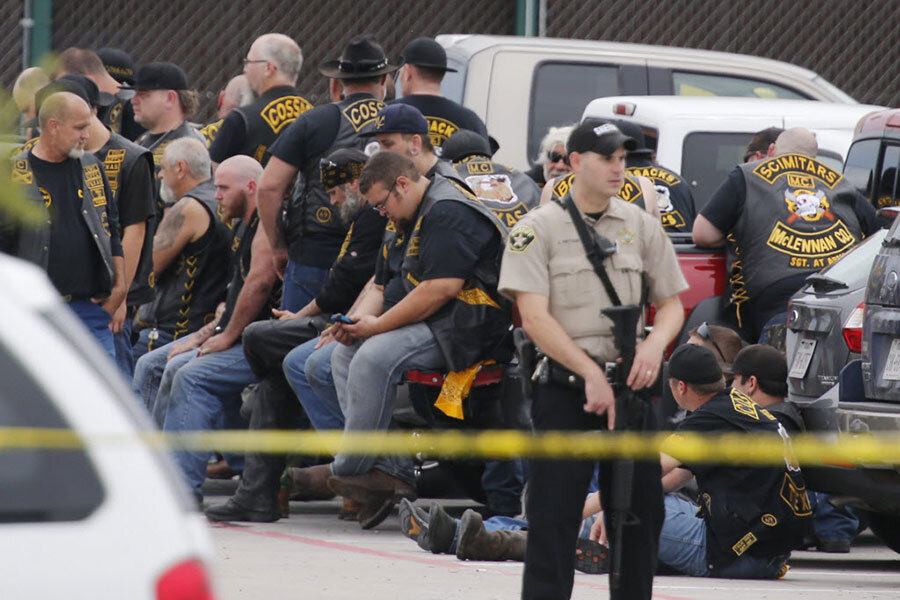What Waco biker shootout suggests about race in America
Loading...
The shootout in Waco, Texas, Sunday between two outlaw biker gangs that left nine members dead has led to a controversial question: What if they had been black?
In the immediate aftermath of a shooting that a local police sergeant called "the worst crime scene, the most violent crime scene I have ever been involved in" – and which involved gang members shooting at police – photos show the gang members sitting at their ease, texting, near police officers. Some ask if that would have been the case if the rival gangs had been in some big city, dressed in gang colors and hoodies, having brass-knuckled, stabbed, and shot at each other – and police.
Media coverage has featured little talk about absent fathers or whether subcultures of violence and masculinity are bred in the type of restaurant where the shootout took place, which features waitresses with ample cleavage and barely-there shorts. Would that have been true if it had happened at a hip-hop gathering or an urban strip club?
To many, such attempts to compare the melée in Waco with the civil unrest in Baltimore or New York or Ferguson, Mo., strains reason and evidence. What happened in Waco was in no way a riot. It was a deadly bar fight, plain and simple.
But even that view speaks to how different communities can see the same event differently, say others. It points to "selectively biased concern," says Aram Sinnreich, professor of journalism and media studies at Rutgers University’s School of Communication and Information in New Brunswick, N.J. In other words, Waco reveals the way people's cultural background influences their perceptions of crime and violence – from a mass shooting by a white gunman in Aurora, Colo., to violent protests after the death of a black man in Baltimore.
For many white Americans, biker gangs – while threatening – are at least culturally familiar. At times, biker gangs have been romanticized in white American culture – a tough, on-the-road breed of “outlaws” rather than “thugs.”
“Here we have a very popular television show about violent white biker gangs, ‘Sons of Anarchy,’ but no one is wringing their hands or pointing their finger that we have to investigate that kind of entertainment,” says Professor Sinnreich.
But the problems of black communities in some ways remain opaque to many white Americans, leading to concern, when violence breaks out, about single parenthood, the glorification of “thug life,” and overtly sexual lyrics of some hip hop music. Sen. John Cornyn (R) of Texas said after the death of Freddie Gray in Baltimore: “Liberals, admit it: Baltimore riots are part of a story of absent fathers.”
Those are legitimate concerns. But that concern is often not reciprocated for similar aspects of white culture, some media analysts say.
“When white people commit violence, they are typically framed by the media as discrete events that are only reflections on the individuals who are central to them,” says Sinnreich. “When black people commit violence, the media typically covers it as an indictment of the symptoms plaguing black Americans overall.”
That perception has led to some activists and members of the black community to comment on the lack of hand-wringing that has accompanied the Waco shootout.
One community activist sarcastically tweeted:
New York Times columnist Charles Blow added:
The Atlantic's Ta-Nehisi Coates, repeated some of the questions pointed at black protesters.
For other conservatives, the Waco gunfight was clearly different. “Making the comparison with Baltimore, many on the left ... demanded to know why the media did not describe the events in Waco as a ‘riot,’ ” wrote Kevin Williamson at The National Review, calling the comparisons “stupidity.” “The answer, obviously enough, is that the event in Waco was not a riot – it did not represent a general state of civil disorder, there were no mobs targeting property for destruction, etc.”
A deeper question, however, is whether violent crimes by whites and minorities generate the same level of media soul-searching.
“It is really interesting that the kinds of stereotypes and race-based arguments that occurred around the property destruction in Baltimore and the shooting [of two would-be terrorists in Garland, Texas] do not surface in the stories about the biker gang shootout,” says Gordon Coonfield, professor of media studies at Villanova University in Philadelphia. “And then there is the connection between violence and masculinity. ‘Breastaurants’ like Twin Peaks cater to misogynist gender stereotypes that are also at work here.”
Various kinds of cultural assumptions, mostly unsaid and even unperceived, are often at work, adds Sinnreich.
“The reality is that whether we’re explicitly talking about race or not, the way that we cover events in the media becomes an element in our national conversation on race,” he says. “The implicit presumptions that we bring to bear when covering a story about the motivations or the virtues or the vices of the people concerned reflect larger unsaid cultural assumptions about the social groups that those people come from.”






